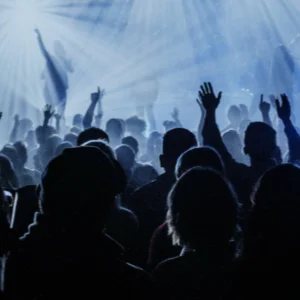In an interview, Peter Hook once remarked that Joy Division “definitely was a punk group.†But, over the years, this distinction has been somewhat separated from the group by the public at large, or at least by critics, and Joy Division has been re-contextualized as a “post-punk†or “indie rock†band. What makes this even more tangled is that, while New Order, Joy Division’s successor band after the death of frontman Ian Curtis, started out as a cold-burning rock (or post-punk or punk or whatever) group, their few danceable singles came to define them in the mainstream. The result of this was that while New Order was very much an icy, avant-garde rock band on their first four albums, they too were re-contextualized as a dance music group, and even as an electronic one at that.
It seemed that Peter Hook and the Light came to Philadelphia’s Trocadero theatre on November 25 to disprove these simplifications of both of his mainstay bands. The crux of the tour was that the band was going to play all of Substance, that is the first set of the show would be the entirety of New Order’s greatest hits album under that name, and the second set of the show would be Joy Division’s hits LP of the same name. Yet, while the band did play all those songs over its massive 150 minute set, we weren’t presented with the modern sanitized version of these bands (the likes of which the current Hook-less version of New Order seems to content to pitch).
Rather, as the first set began with “In a Lonely Place,†Hook and the light made it a real point to underscore the grit and power in these songs. Martin Hannet’s production famously cooled the band’s sound to a cool steeliness. By contrast, Hook presented these songs as hot, rumbling, charges. The band reveled in the low end bass power of “In a Lonely Place†to the point where it almost felt like it had elements of Black Sabbath fueling its power. Frankly, it was striking how huge and energetic these songs were. One might counter that it’s a form of blasphemy to strip these songs of their iconic aloofness. Not so, proved Hook. With these songs amped up and raw sounding, they proved that the internal menace of these songs comes not from their studio strategy, but from their inherent structure and massive size of these compositions, compounded with the conviction in the artists’ playing.
Likewise, “Ceremony†was driven by a thundering drums, resulting in an energetic take on the song that, instead of becoming a quick run though, made the song’s inherent meaning that much more personal and vibrant. Somehow, when there songs were beefed up, they became more daring, more fearsome things. Listening to the live material released as part of the Joy Division/New Order reissue series, it does seem that this strong-backed charging was the band’s true intention.
The second half of the New Order set did feature the previously mentioned “dance†songs such as “Bizarre Love Triangle†and “Blue Monday.†While those songs did feature some laptop beats, the band supplemented the dancehall sound with the grit, feedback, and random nature of live instruments. Frankly, it made the songs punch harder and as more befitting for the venue than other possible strategies. The fact is, of the possible versions of these tunes that one can choose from, between the studio recordings, live albums, and performances, Hook made a hell of a strong case for New Order as the raw, massive-sounding, live rock group.
After a short intermission, the band returned to the stage and dug into their Joy Division set. To my surprise, it seemed that the audience was split evenly between being more Joy Division fans and being more New Order fans. I would have put my money on Joy Division as being the crowd favorite, but it seemed that the split was nearly fifty/fifty.
The Joy Division tunes were where Hook really reveled in the pure power of his low, swinging bass. Joy Division’s music is built on a dark melancholy, and the fact is, a great portion of that comes from Hook’s ominous instrument. As with the New Order cuts, the band upped the tempo, muscularity, and fragility of these tunes, even further making the argument that Joy Division was a punk band- a mammoth sounding, infinitely dark punk band.
Of course, this was underscored when the band ripped into one of their earliest songs, “Warsaw†which, with its storming attack, could be considered a proto-hardcore song. “She’s lost control,†which is often presented as the lagging, dire lament, was given an added hardness and wiriness. This, too, made the Joy Division songs preserve their inherent character and depth, while attaining a sort of hungry disposition.
Hook handled the vocal parts of Curtis. Instead of mimicking Curtis’, Hook relied on his own low, rumble growl, which does have a distinct Curtis’ vibe. But, in contrast to that distanced, drifting Curtis delivery, Hook is more interested in matching the live take’s fire, by adding his own lively, morbid delivery. It works really, really well.
Hook and the Light have been touring fairly relentless for the past five years and seem that they have a few things to prove. Other members of other bands have, to a degree, sough to diminish Hook and his contributions, and some publications have picked up this wave and road along with it. Well, the proof is apparent and its been apparent for some time. First, Joy Division and New Order are not just what the studio recordings make them out to be. Second, these bands as pulsating punk (or almost punk) bands very well may be their best incarnation. Third, Hook has proved all he needs to prove. If he retired tomorrow, his mark on music, his contributions to these bands, and frankly, his argument for what these bands should be is undeniable.
